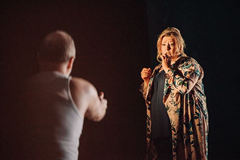| Opera Reviews | 29 April 2024 |
An emotional roller coasterby Catriona Graham |
|
| Bartok: Duke Bluebeard's Castle Paterson: The 8th Door Scottish Opera April 2017 |
|
|
This is no 50 Shades exploration of the darkest corners of the psyche. She says she doesn’t want roses and sunlight, but wants to open the doors and let in the light. He tries to resist – shows her his torture chamber and armoury, gives her the keys to his treasure, his garden and his kingdom. But she wants to know more. Any Agony Aunt would advise her – don’t go there – but she insists. After the white lake of tears, she opens the seventh door, behind which are his previous wives. Robert Hayward and Karen Cargill are utterly convincing as a couple having one of those conversations, impassioned, evasive, prodding and their voices are well-matched. She knows he has a past – as does almost every adult – and keeps picking away at it. In this production, the three wives appear as the ghosts of previous relationships, baggage of the past we all carry round with us. Throughout, the emotional temperature of the singing is mirrored in Kai Fisher’s lighting effects. Cargill’s voice is full of enchantment at the curtain of glitter which symbolises the treasure, but there is horror in her voice as her hands turn red from the blood-stained treasure. It is paired with The 8th Door, co-created by Matthew Lenton and composer Lliam Paterson in a co-production with Vanishing Point. Six off-stage voices – three men, three women – sing while, on-stage, a man and a woman converse. But they are not face-to-face – with their backs to the audience, they speak to camera and their faces are projected in turn on a large screen. The words they speak are unheard but do not necessarily bear any resemblance to the words sung and projected as overtitles. Had I not read the programme notes, I would have assumed it portrayed a relationship sustained (or not) through a medium such as Skype. But it is, apparently, concerned with the ‘surface’ of things as against deeper feelings. Musically, there are some deliciously lyrical passages, discordant brass, percussive passages and the orchestra, including the offstage band, plays with verve for conductor Sian Edwards. The off-stage voices are mic’d, which helps with the vocal effects .At one point when, on screen, the woman is clearly upset, a man is singing of turning from a deer into a wolf, of having left his antlers behind on a tree. It is, undoubtedly, a true Gesamtkunstwerk. Without the visuals on stage, the score is just an interesting collection of words set to music. Together, they challenge us to interpret the looks and expressions of the man and the woman as they come together and then break apart.
|
|
| Text ©
Catriona Graham Photo © Mihaela Bodlovic |

 There are many ways to present Duke Bluebeard’s Castle, Bartok’s opera about a couple. For Scottish Opera’s production, director Matthew Lenton has gone to the realistic end of the spectrum. His couple come (from the bedroom?) in jim-jams and dressing-gowns into the living-room – desk with laptop and chair, leather sofa with cushions and talk.
There are many ways to present Duke Bluebeard’s Castle, Bartok’s opera about a couple. For Scottish Opera’s production, director Matthew Lenton has gone to the realistic end of the spectrum. His couple come (from the bedroom?) in jim-jams and dressing-gowns into the living-room – desk with laptop and chair, leather sofa with cushions and talk.






